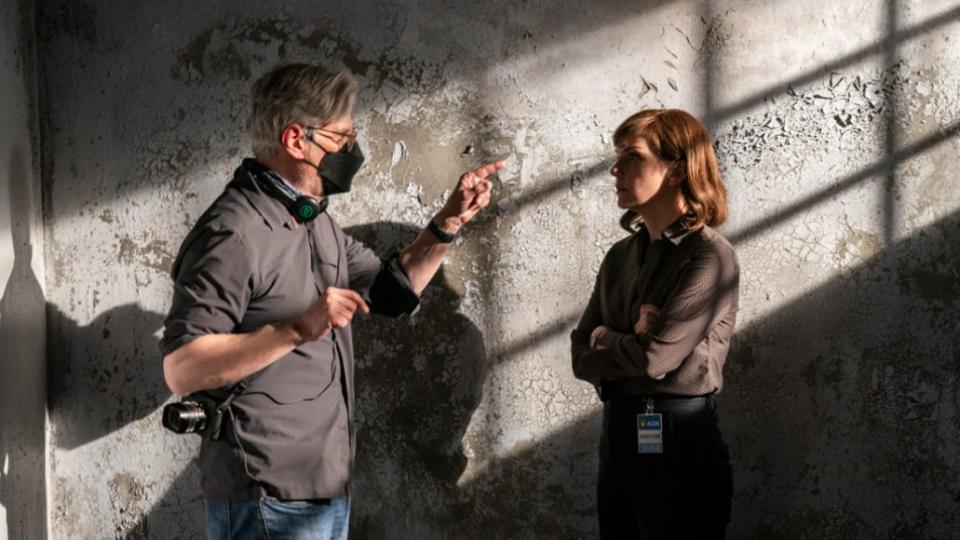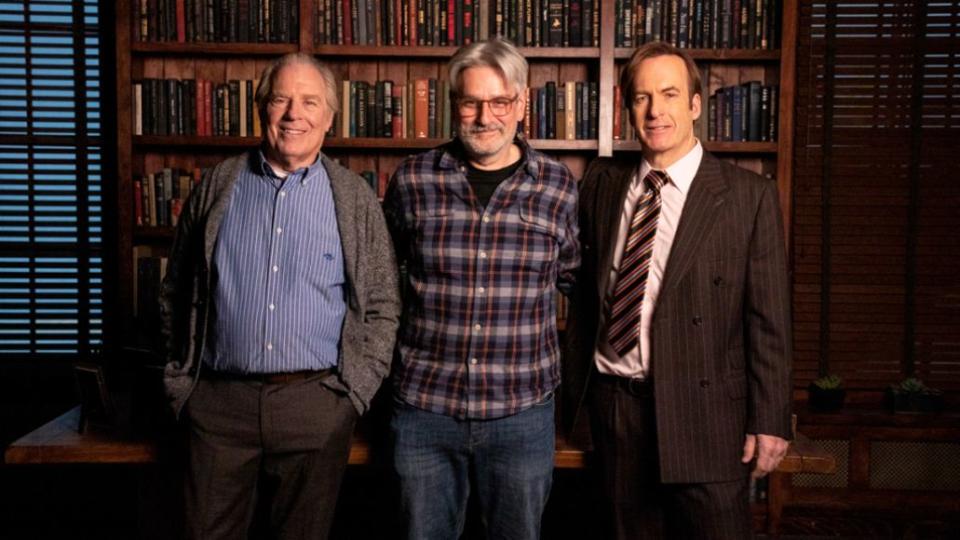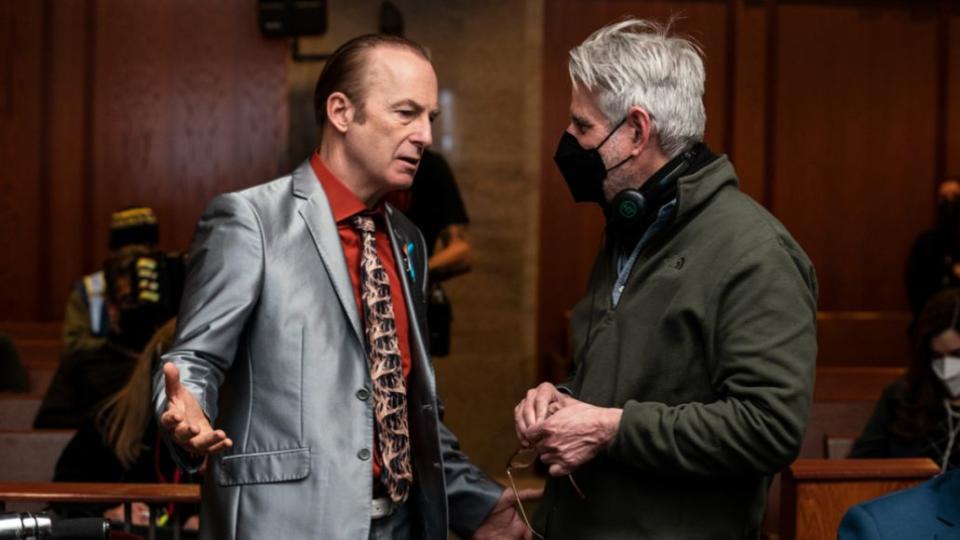Better Call Saul: 7 Big Questions About the Series Finale, Answered
- Oops!Something went wrong.Please try again later.
- Oops!Something went wrong.Please try again later.
- Oops!Something went wrong.Please try again later.
- Oops!Something went wrong.Please try again later.
- Oops!Something went wrong.Please try again later.
The post Better Call Saul: 7 Big Questions About the Series Finale, Answered appeared first on Consequence.
[Editor’s note: The following contains spoilers through the series finale of Better Call Saul, “Saul Gone.”]
There’s so much to be asked, when one of television’s great achievements comes to an end. So the morning after the Better Call Saul series finale aired, co-creator Peter Gould and stars Bob Odenkirk and Rhea Seehorn very generously spoke with reporters via Zoom for a press conference that explored so many aspects of the final episode, “Saul Gone.”
Below, Gould, Odenkirk, and Seehorn answer maybe not all, but at least a few of the biggest questions from the end of the season, from the choice to continue filming in black and white, what was cut from the finale, and when the idea to have Jimmy end up in prison first came up (and why that nearly caused problems with another Breaking Bad property).
The Team Never Got Any Pushback Over Going Black and White

Better Call Saul (AMC)
From the beginning of Better Call Saul, Jimmy/Saul/Gene’s post-Albuquerque life was filmed without color, but for the bulk of the show’s run this just meant a few scenes a season — it wasn’t until the final stretch of episodes that the producers realized what adhering to that creative choice would mean. “We were a little scared about having so much of the show in black and white,” Gould said. “So for a long time, there was the the idea of getting into Gene’s timeline and then switching into color.”
However, continued Gould, “that really felt wrong, because it’s a little like Wizard of Oz, to go from black and white to color. I think that would have maybe gave the wrong feel to those scenes. So we took the plunge and said, it’s all gonna be black and white. And you know what, we didn’t get a single bit of pushback from the studio or the network, which I think is very impressive, that they allowed us to do so much of the show in black and white. Hopefully, the audience went along with it. I love black and white.”
Were the Final Scenes Difficult to Shoot?

Behind the scenes of Better Call Saul (AMC)
“It was the easiest scene we ever shot,” Odenkirk laughed while asked about the final scenes, in which Jimmy and Kim reconnect, and he wasn’t exactly joking. “It’s really just a lot of feelings from six years of working together and playing these people, and it’s one of the few times that one of them isn’t sort of trying to manipulate the moment… This was deeper than that.”
So, Odenkirk said, “But I do think these are two people who belong together, who are comfortable with each other in a deep way, which is a great thing for a long term relationship. I think that was the easiest scene to play because you could just let go of all the manipulation and wanting something to be different or arguments that they might need to be making. They could just exist next to each other — something they very much like to do.”
Said Seehorn, “It was the last scene we shot, the very last scene we shot of the series and there’s a lot of real circumstances where the Venn diagram of what you’re supposed to be playing overlapped.” And she agreed with Odenkirk that “they are without artifice and without armor and sort of maskless to each other, which is the best part of their relationship — that they were able to be that for each other.”
Seehorn praised how “perfectly written” the scene was, saying that “He tries to make her laugh a little bit, somehow letting her know it’s okay, because he can see that she’s scared for him. It’s such an economic scene — Peter’s so great at not overwriting it and trusting us and trusting the audience.”
Gould confirmed that “I had paired that scene down. There were versions of that scene that I had written where there was a lot more said and a lot more catching up and it just kept getting leaner and leaner as I worked on it because in a weird way, they don’t have to say that much to each other. They’ve come to a conclusion. And so it was, it was shooting. It was incredibly moving.”
There was one tough element to the sequence, though, according to Gould: “The cigarettes were a real difficulty, because both Bob and Rhea were coughing and my eyes were running — I had cigarette smoke down my throat for a couple of days afterwards. It looks so cool. But it’s really not good for you. So thank you, Bob and Rhea for for being willing to smoke.”
Was the Idea Always For Jimmy/Saul/Gene to End Up in Jail?

Behind the scenes of Better Call Saul (AMC)
While no comment was made on whether this was the idea from the beginning, Gould confirmed that “we had an image in the writer’s room sometime in Season 4 or 5 that he would end up in jail.”
This nearly led to a conflict with another project in the Breaking Bad-verse, as co-creator Vince Gilligan was working on the stand-alone film El Camino: A Breaking Bad Story during this time. “He came into the room to pitch us potential endings for El Camino, and one of the endings was very similar to [Better Call Saul‘s ending], except for Jesse.”
Added Gould, “Of course it was beautifully pitched and beautifully thought through, like everything that Vince did, I got a little cold breeze on my back. I felt a little sweaty. Because I just felt so strongly that the right ending for Saul was to be in the system, the system that he’s made light of and that he’s twisted around for his own purposes… So hopefully Vince won’t be mad, but some of us, I especially said, ‘You know, what about another ending for Jesse?'” Gilligan did follow through on that, and El Camino instead ends with Jesse making his way towards a new start in Alaska.
Said Gould, “I think the ending he came up with for Jesse was exactly the right one. Of the three shows, it just feels very elegant to me that Walt dies, which he was always going to do — I mean, that was set from the beginning, but he dies really on his own weird twisted terms. Jesse suffers greatly — he’s in a prison of his own for quite a while. And then he gets away and maybe starts this healing. And of the three of them, Jimmy gets his soul back, but he’s going to be incarcerated for some amount of time. That just felt right — that these three heroes… anti heroes, whatever you wanna call them, protagonists… That they each have their own ending.”
Oh, and also, Better Call Saul has another element to consider. “Kim Wexler is just so important to us, and at this point in the show she’s kind of co-protagonist — and she has a very hopeful ending in my book. So it throws certainly throws Breaking Bad and El Camino into a different light.”
Was Anything Cut From the Finale?

Behind the scenes of Better Call Saul (AMC)
Gould told reporters that there were a few elements of the finale that took a bit of time to lock down. For one thing, he says, “the finale was considerably longer than what aired.”
Things that were cut, he said, include “some directorial flourishes,” as well as “a couple of scenes of the chase in the opening that we took out, because I think it was important to all of us, especially to me, that it would feel like another episode of the show and not some kind of giant double truck movie finale, because it’s not. This episode is very much in keeping with the last few, and so it was important not for it to feel excessively weighty or slow.”
He added, with a bit of a laugh, “There were some very nice performances that were minimized.”
In addition, he said, he was “on the bubble” when it came to the very last scene of the episode, and nearly cut the final moments exchanged silently between Kim and Jimmy, across the prison yard. “There was a version that didn’t have [the prison yard scene], that ended with the two of them smoking. And I went back and forth on that for a while, and then ultimately having watched them both, I felt like it was right. It felt more honest to end with the two of them apart rather than the two of them together.”
Earlier in the process, the writers had a different approach to the final scenes. “When we first broke this episode, the two of them were meeting in Albuquerque, before he went to prison. And the last scene was him in prison by himself thinking. And I like that a lot, but it seemed a little cold. I think ultimately we all felt like ending with the two of them felt like the strongest way to go,” Gould said. “Also in the original version, he was fearful about what was going to happen to him in prison and was a lot about the fear. And this is a very different scene. It’s a scene that is mostly about connection — a wistful connection.”
What Was Up With The Time Machine References?

Behind the scenes of Better Call Saul (AMC)
A thread running throughout the series finale is the question of “What would you do with a time machine?”, which Gould said was “a way of talking about regrets, but it’s also a way of being honest. It’s a way of talking about being honest with yourself, which is maybe the hardest kind of honesty to come by.”
As he continued, “So much of the show is about the choices that these characters make. You’re screaming at them go the other way, you know, ‘Please, just wake up!’ But the truth is that a lot of us spend our lives doing things because we want to, or because something in us causes us to do them. It’s a hard thing, to examine yourself and, and examine your actions and take charge of them. The Time Machine was a way to think about that.”
To be clear, Gould said, “the real book is not about that. The real book is about civilization and class and all kinds of other things, but these characters use the idea of a time machine as a way of thinking about alternatives, alternatives that they could take.” Gould confirmed that “literally that copy of The Time Machine somehow made its way from Chuck’s into Jimmy’s possession. And Jimmy knew that Chuck was reading it.”
But he added the idea actually originated from Season 4, when Kim gets into a car accident and Jimmy’s watching over her while she sleeps, reading a book to pass the time. “And the book that we picked was a copy of The Time Machine, and I remembered that Bob was reading it while we were shooting. And Bob said, ‘Hey, this, this book’s pretty good.’ And I think that stuck in our heads.”
How Long Did It Take to Shoot Saul Goodman’s Big Monologue?

Behind the scenes of Better Call Saul (AMC)
According to Odenkirk, there were two days originally scheduled for Odenkirk’s big final speech, and “it was extremely emotional on the second day, and Peter still had one or two angles he needed to get. So we were gonna have to come back for a third day, an unplanned third day. And then I said at the end of this long grueling killer day, ‘If it’s okay with you, I want to reshoot the whole monologue.’
“Everybody who overheard that little conversation wanted to kill me,” Odenkirk continued, “They were like, ‘No, it was great. You were great.’ What happened was, I played it and it got very emotional and I’ve become more and more skeptical of gushing emotion on screen. And it felt wrong in this courtroom scene, and I wanted to do it with a more restrained presentation. What I’d done, even if it had played true and played impactful, it just felt wrong.”
That third day ended up not being that long — Gould said they were even able to move to a different location after finishing the monologue — and Gould felt that doing the reshoot was “super-important… There have been times when we all think, ‘Oh, let’s pick something up.’ But Bob felt so strongly and it was a really important scene. So obviously we went back.”
Also, added Gould, “we simplified the dialogue a little bit. Bob and I talked about it and there were a few lines that were shot on the first go-through that we didn’t do the second go-through. In the editing room, we used both performances, but we did use the simplified dialogue and I was very happy we did.”
What Was Bob Odenkirk’s (Joking) Idea for the Ending?
After Gould praised his assistant, a trained lawyer who helped with the legal aspects of the episode, Odenkirk had a question. “Was she the one who nixed my proposed ending, after Saul makes his confession? Where the judge bangs her gavel and announces, ‘I’ve literally never seen anyone be so honest in my courtroom?’ And then she takes her robe off and puts it over Saul’s head and says, ‘Here, you sit here,’ and gives him a hundred dollars and she goes to jail?”
Laughed Gould, “Why didn’t we do that?”
Added Odenkirk, “I believe the last scene is the judge in jail crying.”
“Now you see why we love working with Bob,” Gould said.
Better Call Saul is streaming now.
Better Call Saul: 7 Big Questions About the Series Finale, Answered
Liz Shannon Miller
Popular Posts
Whoops! Tommy Lee Posts Full Frontal Nude Selfie on Instagram, Facebook, and Twitter
Metallica's James Hetfield Files for Divorce from Wife of 25 Years: Report
Corey Feldman Says Marilyn Manson Sabotaged His 2017 Tour: Exclusive
Pete Davidson in Trauma Therapy Following Harassment from Kanye West: Report

